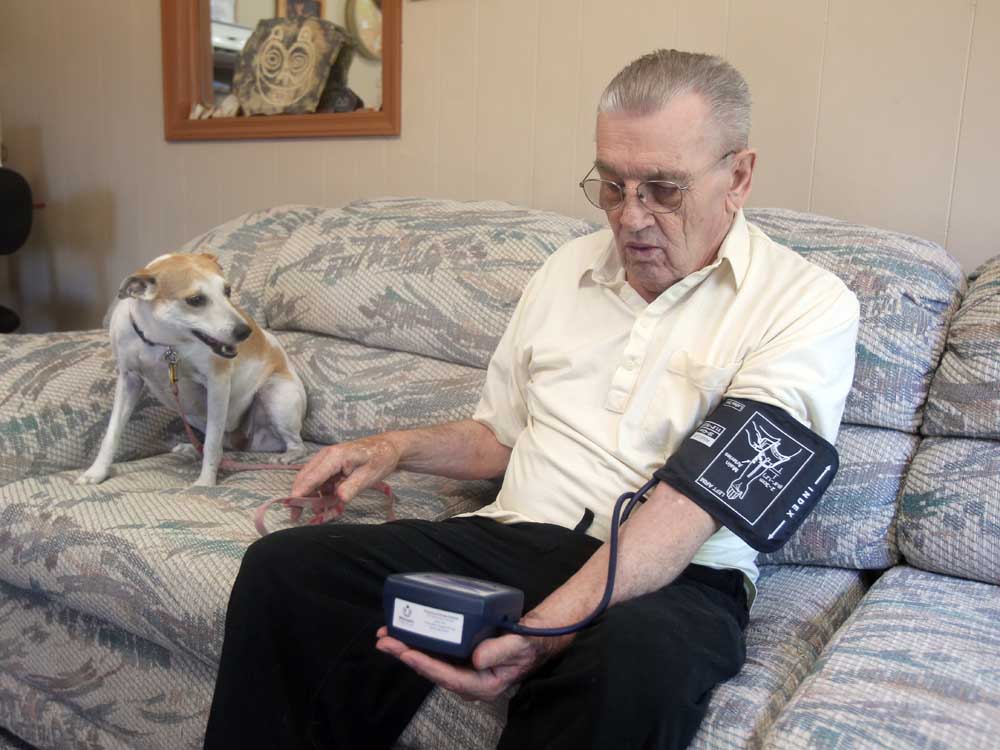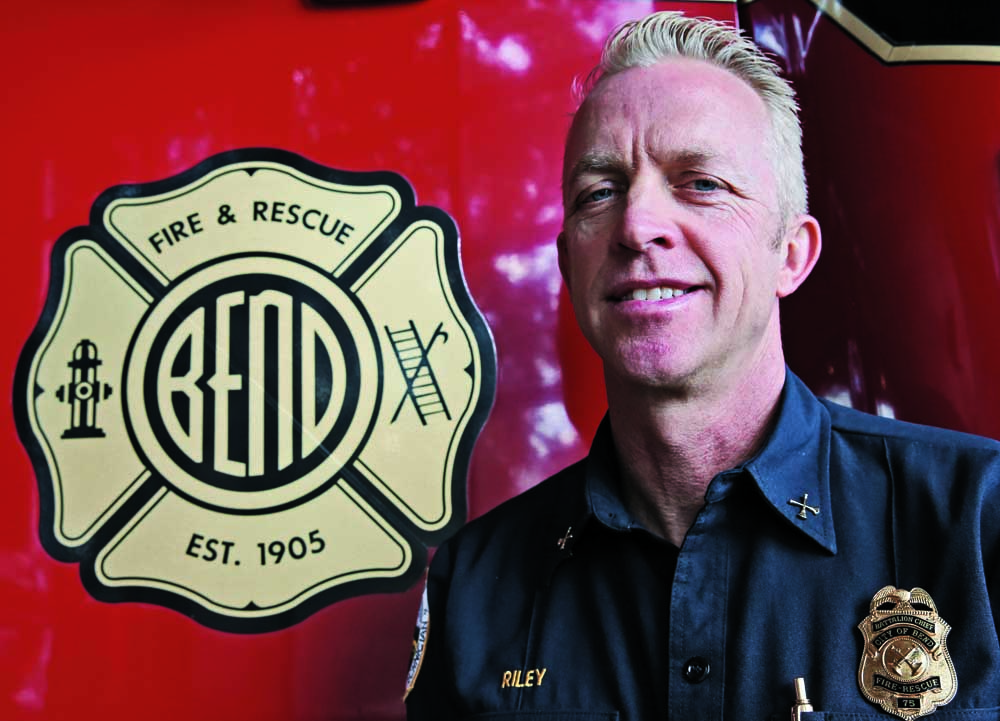Patients learn to monitor own vital signs
Published 12:00 am Thursday, October 9, 2014

- Andy Tullis / The BulletinKen Dalton, 74, tests his blood pressure while his 8-year-old dog, Sasha, watches at their home in Prineville last week. Dalton is borrowing the machine through a Mosaic Medical program that encourages patients to check their own vital signs at home.
Ken Dalton is first to admit it: He should have warned his friends about the possibility that he could “go off the air” at any moment.
That’s what happened at a church picnic at Prineville Reservoir a few months back. It was a hot, midsummer day, and the 74-year-old Prineville resident — who had a pacemaker and defibrillator implanted in 2010 — didn’t realize his heart rhythm had gone out of whack.
That is, until — “Wham! That defibrillator went off and knocked me to the ground,” Dalton said. “It was like getting hit by a mule.”
Needless to say, he’s watching his health pretty closely these days. Luckily, he’s got help. Dalton is among 79 Mosaic Medical patients who are currently participating in a federally funded test to see whether teaching patients to use medical equipment to check their health indicators at home will improve care and save money for patients and providers alike.
Mosaic’s Prineville clinic launched the three-year project in September 2013 using a $750,000 grant from the Health Resources and Services Administration, which has been funding such projects to increase health care access for people in rural areas, where it’s not always easy or feasible to get to a doctor’s office.
The patients get blood pressure monitors, oxygen saturation monitors and scales to use at home. They take their readings at least once per day. When they do, the equipment uses wireless technology to automatically transmit the numbers to a software program. If a patient’s numbers are off, he or she gets a phone call from a Mosaic staff member.
Dalton would never have thought of checking his blood pressure before having the equipment at home, but now he said he’s much better about paying attention to his health.
“It’s kind of a reminder right in your face about, ‘Go do some exercise,’” he said.
The project is going so well, its leaders are expanding it to the Redmond clinic, and they’ve got their sights on bringing it to Mosaic patients in Madras and Bend, too.
Andy Eck, the manager of Mosaic’s Prineville clinic, said it’s looking increasingly likely that HRSA will pour more money into the project even after the current grant runs out. If not, he’s hoping other Central Oregon providers — perhaps coordinated care organizations, the groups that administer Oregon’s Medicaid program, the Oregon Health Plan — will recognize the program’s value and commit their own funding.
Patients who benefit the most are those with multiple health conditions, such as high blood pressure, diabetes, obesity or high cholesterol, said Aimee Priest, Mosaic Prineville’s RN care coordinator. It’s also patients with transportation barriers, those who live far from clinics or don’t have cars, she said.
The success of the program lies in its ability to cut down on patient visits, both to emergency rooms and outpatient clinics, because patients can monitor their levels at home.
A typical patient with hypertension, for example, has to come in every 30 days if they’re on new medication, Priest said. If their levels look good, however, they can cut that down to every three months, she said. Often, Priest or another staff member will tell patients’ providers to make medication adjustments, which also reduces the number of office visits.
That’s important, as for many patients — especially those who live in rural areas or low-income patients who rely on OHP — getting to the doctor’s office isn’t always possible.
That’s the case for Laura Koehn, who lives at the top of a canyon southeast of Prineville that can be impassable for months after snowstorms.
One year, when her late husband was very sick, her kids — who’ve now grown up and moved away — placed him on the hood of an old car, tied it to a rope and dragged him over the snow to the highway so a passerby could take him to the hospital.
“If you live rural like we do, and have had challenges getting to town, it’s definitely a good program to be on,” she said.
Koehn, 68, has diabetes, high blood pressure and asthma. She also has had a heart attack and underwent a bariatric surgery in July. She was among the first group of patients enrolled in Mosaic’s monitoring program almost a year ago. She checks her levels daily — more than that if she’s not feeling well.
“Sometimes when I don’t feel good, I can take my blood pressure and, ‘Oh, It’s OK, so that’s not what’s causing it,’” she said. “It’s the security of knowing that there is something you can do if something is wrong.”
Mosaic Prineville is working on hiring more doctors, but in the meantime, appointments can be further out than patients would like, Eck said. For some, taking a couple hours off of work to go to the doctor creates financial strain, he said. Others have mobility issues that could make coming to a clinic physically or mentally exhausting, Eck said.
“This allows patients to really get direct contact with an RN who has the ear of a provider to make those decisions immediately, which is great, without having to actually come in,” he said.
Very few community health clinics are currently using remote monitoring programs — often referred to as telehealth programs — with their patients, said Bob Wolverton, program director for the Northwest Regional Telehealth Resource Center, a group that provides technical assistance for telehealth projects in Alaska, Idaho, Montana, Oregon, Utah, Washington and Wyoming.
In the future, Wolverton said health care providers will increasingly need to work with patients remotely using technology given the aging baby boomer population.
“Right now, it’s almost a toe-in-the-water situation, and Mosaic is wading in with both feet,” he said.
The U.S. Centers for Medicare & Medicaid Services has eyed telehealth as a strategy for reducing repeat hospital admissions within 30 days, Wolverton said.
“If some of their numbers start going off just a little bit, they’ll be contacted by a nurse who can talk to them about what’s going on,” he said, “rather than just waiting for their situation to become an emergency.”
— Reporter: 541-383-0304,
tbannow@bendbulletin.com







